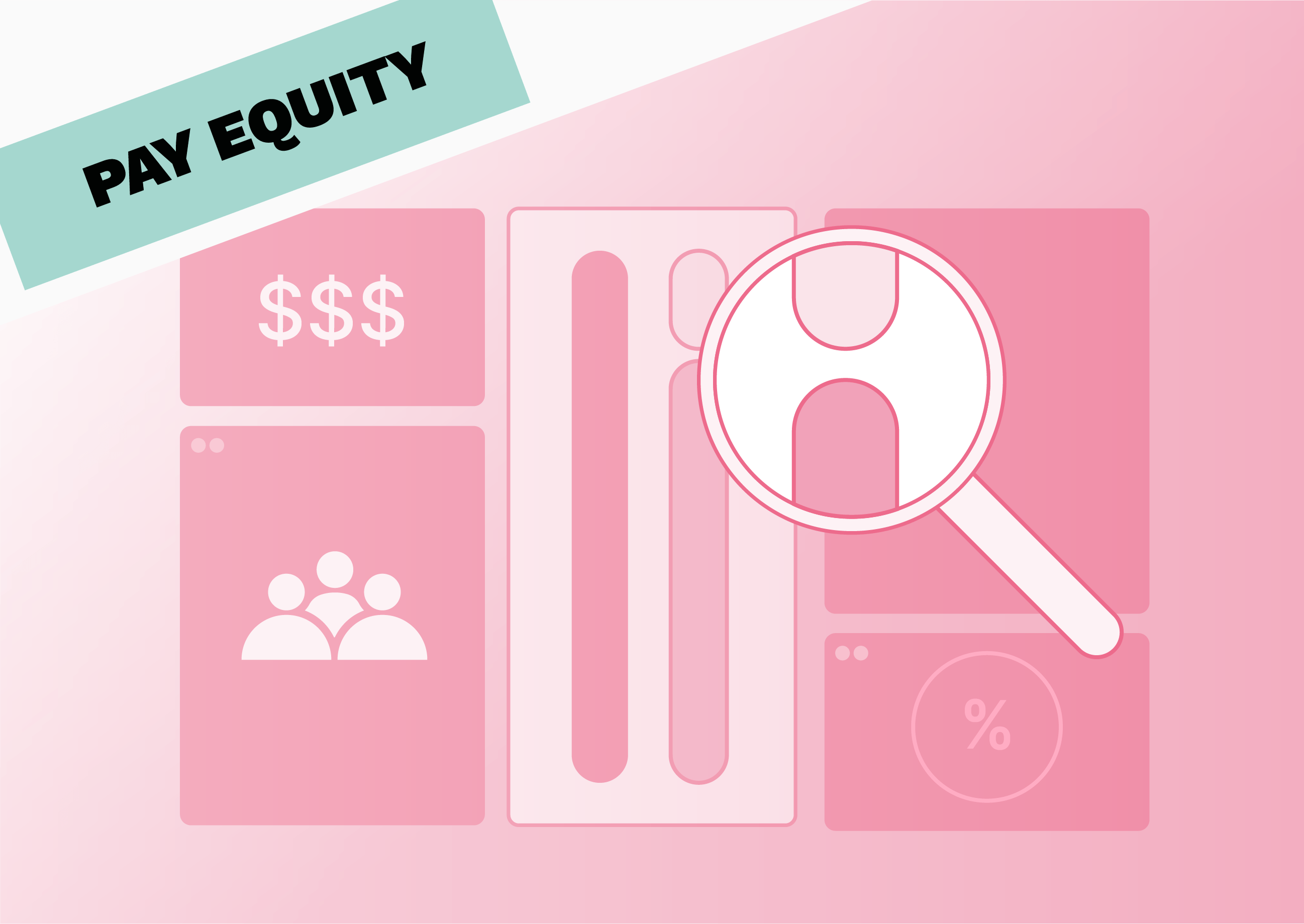Let's be honest – “we pay based on vibes” isn't a defensible HR strategy. Pay equity is all about equal pay for equal work, but often, that’s not the case. One employee starts on a higher salary because they asked for more money, while another gets paid less for the same job because they didn’t.
That’s not fair, and a pay equity analysis is the best way for companies to uncover and then resolve these kinds of inequities. Ensuring pay equity also means companies can attract and retain top talent, build a strong company reputation, and comply with pay transparency laws.
Here's the thing: with the EU Pay Transparency Directive landing in 2026, what used to be "nice to have" is becoming "must have." Companies that aren't ready will face hefty fines, legal headaches, and some seriously awkward conversations with employees. But here's the good news – starting now puts you miles ahead of the last-minute scramble.
Pay equity compliance is the process of ensuring employees are compensated fairly regardless of protected characteristics. Compliance involves analysing pay practices to identify disparities. Organisations must adhere to relevant laws and maintain transparent pay structures.
If you’re ready to find out how to conduct a pay equity analysis, you’re in the right place. We’ve included a step-by-step guide, best practices, common challenges (and how to solve them), plus everything else you need to know.
What is pay equity compliance?
A pay equity analysis uses data collection and statistical analysis to identify inequities. By comparing employee pay across factors such as gender, age, ethnicity, performance, and seniority, companies can ensure that employees are paid fairly.
But let's be real – compliance is about more than running numbers once a year and calling it done. It's an ongoing commitment to fair compensation practices that keep up with ever-changing regulations. Think regular audits, transparent communication, and staying on top of what's required in every country where you operate.
This analysis brings many benefits, including:
- Solves pay inequities: Helps identify unjustified pay gaps, leading to fair pay for all employees.
- Promotes fairness: Fosters an equitable and transparent workplace culture, where employees feel valued.
- Ensures pay equity compliance: Helps companies follow pay transparency laws and avoid the risk of non-compliance fines.
- Boosts employer brand: Helps position companies as inclusive, ethical champions of fair pay.
Key principles of pay equity
- Equal pay for equal work: Employees performing substantially similar work receive comparable compensation.
- Transparency: Clear communication about pay structures and progression.
- Regular monitoring: Continuous assessment rather than one-time fixes.
- Legal adherence: Meeting all federal, local, and EU requirements.
Pay equity compliance reduces legal risk through proactive gap identification. Overcoming barriers to pay transparency builds trust between employees and management. Fair compensation practices support employee retention.
When and why should you conduct a salary equity analysis?
In 2026, the EU Pay Transparency Directive comes into force, meaning companies in Europe have to report on gender pay gaps. Starting the analysis process now makes the reporting process much easier, because you’ll already know what to do.
Most companies should complete a pay equity compliance review annually, but this is set to change:
Here's how often you'll need to report in the future:
- 250+ employees: First report by 7 June 2027, then every year.
- 150-249 employees: First report by 7 June 2027, then every three years.
- 100-149 employees: First report by 7 June 2031, then every three years.
Other times when a pay equity analysis should be conducted include:
- Company audits
- Mergers or acquisitions
And here's where it gets interesting: compliance requirements aren't one-size-fits-all. UK companies have their gender pay gap reporting rules, while German organisations need to wrestle with the Entgelttransparenzgesetz (yes, that's a real word). Bottom line? What's compliant in London might get you fined in Berlin.
Legal compliance checklist
- Understand reporting thresholds for your company size.
- Map compliance requirements across all operating regions.
- Set up systems for ongoing monitoring, not just annual reviews.
- Document all pay decisions for potential audits.
Legal requirements for equal and equitable pay include conducting regular pay audits. Companies must document legitimate reasons for pay differences. he EU directive requires gender pay gap reporting for companies with 150+ employees every three years. Companies with 250+ employees must report annually. Organisations must complete a pay audit and action plan for gaps exceeding 5% under the directive.
Pay equity compliance isn’t just about complying with local or national laws, though. The most compelling reason is that it helps drive the kind of transparent, equitable pay practices that are essential for your employees to feel valued and your company to perform.
{{cta}}
Steps to conduct a pay equity analysis in the workplace
Ready to start your first pay equity analysis? Here’s your step-by-step guide to getting it right.
Step 1: Collect relevant data
During this step, you’ll need to collect all the data you need. Most of this will be within your human resources information system (HRIS) or other HR databases. The level of data you’ll need to collect depends on how detailed your analysis will be, but usually includes some or all of the following:
Salary information
- Benefits
- Bonuses
- Starting salary
- Current base salary
- Variable compensation
Position information
- Team
- Job title
- Department
- Job description
Employee demographics
- Age
- Tenure
- Gender
- Ethnicity
- Seniority
- Potential
- Promotions
- Performance
- Weekly working hours
The more variables you include, the more accurate your analysis will be. During this process, it’s crucial to protect your employees' privacy. Consider how their data will be protected and explain this process to them so they know their data is safe. Follow any relevant data rules and regulations for your region, such as the General Data Protection Regulation (GDPR), which applies to companies within the European Union.
Step 2: Define comparable groups
Now, it’s time to split employees into different, comparable groups. These could include:
- Job role and responsibilities
- Skills and qualifications
- Seniority
- Location
Step 3: Identify pay disparities
Analyse your data to uncover inconsistencies, pay gaps, or other inequities. Depending on the size and structure of your company, this could be an internal process or completed with the help of external experts.
💡Quick tip for compliance: Zero in on the big gaps first. The EU directive flags anything over 5% as "explain this immediately" territory.
For accurate results, choose statistical methods like:
- Descriptive statistics
- Compensation ratio analysis
- Regression analysis:
- T-Tests and ANOVA
These can be completed using software such as Microsoft Excel, Google Sheets, Python, or RStudio. Some HR analytics software also offers statistical analysis.
{{cta}}
Step 4: Define your comparators
Here's where things get a bit tricky. In equal pay compliance, a comparator is basically someone doing work that's equal or of equal value to someone else. Sounds simple, right? Not quite. Legal definitions vary, but typically include:
- Same or broadly similar work.
- Work rated as equivalent under job evaluation.
- Work of equal value in terms of demands.
Word to the wise: document your comparator methodology like your compliance depends on it (because it does). Regulators love to dig into these decisions.
A comparator in equal pay is an employee performing substantially similar work. Comparators share similar skills, effort, responsibility, and working conditions.
Step 5: Investigate root causes
If any disparities are identified, now is the time to figure out why. Some common reasons include:
- Bias
- Lack of salary bands
- Unequal starting salaries
- Outdated salary structures
- Differences in career progression
Step 6: Develop an action plan
Now your compliance review is complete, it’s time to decide how to address any inequities and discrepancies. Short-term actions include making pay adjustments to increase the salaries of underpaid employees and creating standardised salary bands for each role and level.
Longer-term actions include revising your hiring practices, for example, creating inclusive job adverts, not asking employees about their salary history, and ensuring that managers and HR are trained to avoid unconscious bias.
Once the EU Pay Transparency Directive comes into force in 2026, companies with a pay gap of over 5% must complete a pay audit and action plan, showing how these discrepancies will be resolved.
Step 7: Monitor and report progress
Pay equity compliance isn’t a one-off deal. For best results, this process should be conducted annually or biannually. To comply with the upcoming EU Pay Transparency Directive, companies with over 150 employees must complete a gender pay gap analysis every three years. Companies with over 250 employees need to report their gender pay gap annually.
To boost transparency, sharing these findings with your employees is a good idea. Many companies publish information about their pay gaps and how they plan to resolve them.
A compensation communication plan can help outline how to share results with your employees, plus let them know who to contact if they have any questions. This kind of transparent approach can help boost trust and positively impact employee engagement, performance, and retention.
Reducing legal risk through proactive compliance
Let's talk about keeping lawyers happy (and away from your door). Proactive pay equity compliance is your best defense against legal trouble. Here's what actually works:
- Regular audits: Quarterly reviews catch issues before they snowball into class actions.
- Clear documentation: Every pay decision needs a paper trail that makes sense.
- Transparency initiatives: Open communication stops speculation in its tracks.
- Corrective action plans: Fix problems fast and document everything.
Here's the insider secret: Regulators and courts actually prefer companies that find and fix their own issues. It's like confessing to eating the last biscuit before anyone notices – much better than getting caught red-handed!
Pay equity best practices
As pay equity experts, we’ve gathered these best practices together to help make the process a little easier:
- Use reliable data: High-quality, accurate, and recent compensation benchmarking data is essential to identify any discrepancies or inequities properly.
- Involve diverse stakeholders: Leadership, HR, finance, and legal teams need to work together to ensure a comprehensive, compliant review process. Employees should also be kept involved through regular meetings.
- Maintain confidentiality: Employee data needs to be handled with care, ensuring compliance with laws like the General Data Protection Regulations (GDPR).
- Leverage technology: HR tech like Figures can help automate calculations, identify pay gaps, and ensure a transparent, equitable compliance process.
{{cta}}
Common challenges and how to overcome them
Right, let's address the elephant in the room. Pay equity compliance sounds straightforward on paper, but the reality? It can get messy. Here are the challenges that trip up even the best-intentioned teams:
Resistance from leaders
If your senior leadership team doesn’t understand the purpose of a pay equity analysis, they’re unlikely to support the additional time and resources your HR team needs.
💡 Solution: Build a case for business transparency using our six-step guide.
Incomplete or inaccurate data
Data collection forms a significant part of a pay equity analysis, but if your data is inaccurate or incomplete, it’ll impact the accuracy of your analysis.
💡 Solution: Regularly review and update compensation data to prevent any gaps, and use HR compliance tools (like Figures!) to find and correct any gaps or inaccuracies.
Lack of tools or expertise
The statistical procedures needed for a pay equity analysis can be complicated. It can be a major roadblock if you don’t have the right tools or know-how to complete this.
💡 Solution: Work with external experts or use an HR tech platform to assess and resolve any inequities.
Keeping pace with regulatory changes
Remember when GDPR dropped and everyone panicked? Pay equity regulations are evolving just as quickly. What's compliant today might earn you a fine tomorrow.
💡 Solution: Stay in the loop with regulatory updates (shameless plug: our newsletter is pretty good for this). Get cosy with employment lawyers who actually understand this stuff. And choose systems that update automatically – because manually tracking every regulatory change is a full-time job nobody wants.
Tools and resources for pay equity analysis
Pay equity analyses are complicated and require a fair amount of data collection. That’s before you’ve even thought about how to run the actual analysis. The good news is that plenty of HR tools and software are designed to make the process much easier.
Compliance platforms like Figures don't just spot gaps – they keep you compliant without the constant worry. Automated monitoring, regulatory updates, audit-ready reports, the works. Plus, with GDPR, SOC 2 Type 2, and ISO 27001 certifications, we tick all the security boxes your legal team secretly dreams about.
{{cta}}
From compliance to competitive advantage
Here's what nobody tells you about pay equity compliance: Done right, it's actually a secret weapon for winning the talent war. Companies with strong pay equity practices see real benefits:
- Employees who actually trust management (imagine that!).
- A reputation and compensation that attracts top talent.
- Better retention rates (because fair pay = happy employees).
The organisations crushing it aren't just ticking compliance boxes – they're building workplaces where fairness is the norm, not the exception.
Pay equity compliance promotes fairness by ensuring equal pay for equal work. Inclusive workplaces benefit from improved employee engagement. Compliance creates competitive advantage through enhanced employer reputation.
The clock is ticking: Make your move
Here's the brutal truth: In 18 months, every HR team in Europe will be scrambling to meet the same deadline. The companies that start now? They'll be calmly filing their reports while everyone else is pulling all-nighters and praying their Excel formulas are right.
But this isn't really about compliance, is it? It's about finally having the ammunition to win those budget battles. To shut down the "we can't afford fair pay" arguments with actual data. To build the kind of workplace where your best people stick around because they know they're valued – in euros and cents, not just words.
Pay equity compliance is your excuse to fix what's been broken for years. The EU just gave you the perfect cover story.
Ready to get ahead of the chaos?
Don't wait for the panic to set in. Book a demo with Figures and see how companies like yours are turning compliance into their competitive edge. Because when everyone else is playing catch-up in 2026, you'll already be winning the talent war.
P.S. – Remember those awkward conversations we mentioned? They're a lot less awkward when you've got the data to back up your decisions. Just saying.
Summarize this article with AI
No time to read it all? Get a clear, structured, and actionable summary in one click.






